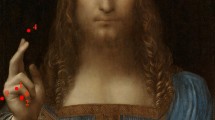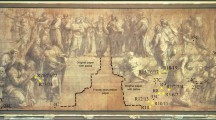Abstract
A survey of gilts applied to stucco surfaces that specifically focuses on the compositions of their colored grounds is reported. Gilt samples of a common geographical (Lombardy in Italy) and temporal provenance (17th–18th century) were studied in the form of polished cross-sections by optical and electron microscopy (SEM-EDS), micro-Raman (μRaman) spectroscopy and Fourier-transform infrared microspectroscopy (μFTIR). Comparing samples with superimposed grounds and gilts enabled light to be shed on the choice of specific materials, their stratigraphic functions, decorative effects, and technological performances. Iron oxide pigments were found in the older grounds, sometimes in the presence of lead white (2PbCO3·Pb(OH)2) or minium (Pb3O4). In more recent grounds, chrome yellow (PbCrO4), chrome orange (PbCrO4·PbO), cinnabar (α-HgS) and barium white (BaSO4), invariably mixed with lead white, were encountered. Evidence for the use of organic mordants (colophony and wax, or siccative oil) was obtained by μFTIR. This combined μFTIR and μRaman spectroscopic and elemental (SEM-EDS) analytical approach enhances knowledge of the composition of gold grounds, their variability and their chronological evolution.







Similar content being viewed by others
References
Matteini M, Moles A (1990) Le tecniche di doratura nella pittura murale. In: Matteini M et al. (ed) Le pitture murali: tecniche, problemi, conservazione. Centro DI, Firenze
Cennini C (1971) Il libro dell’arte. Neri Pozza, Vicenza
Elder PT (1988) Storia naturale. Millenni-Einaudi, Torino
Merrifield MP (1967) Medieval and renaissance treatises on the arts of painting. Dover, New York
Tompshon DV (1962) The practice of tempera painting. Dover, New York
Bonaduce I, Colombini MP, Diring S (2006) Identification of garlic in old gildings by gas chromatography–mass spectrometry. J Chromatogr A 1107:226–232
Katsibiri O, Boon JJ (2004) Investigation of the gilding technique in two post-Byzantine wall paintings using micro-analytical techniques. Spectrochim Acta B 59:1593–1599
Katsibiri O, Howe RF (2010) Microscopic, mass spectrometric and spectroscopic characterisation of the mordants used for gilding on wall paintings from three post-Byzantine monasteries in Thessalia, Greece. Microchem J 94:83–89. doi:10.1016/j.microc.2009.09.006
Duran A, Perez-Rodriguez JL, Jimenez de Haro MC et al (2004) Degradation of gold and false golds used as gildings in the cultural heritage of Andalusia, Spain. Spectrochem Acta B 59:1593–1599
Duran A, Perez-Rodriguez JL, Jimenez de Haro MC (2009) Study of the gilding technique used in polychromed stones and ceramics by dedicated laboratory-made micro X-ray diffraction and complementary techniques. Anal Bioanal Chem 394:1671–1677
Sansonetti A, Zerbi CM, Biondelli D (2008) A comparison of gilding techniques on stuccoes surfaces. In: Proc 11th Int Congr on Deterioration and Conservation of Stone, Toruń, Poland, 15–20 Sept 2008, pp 749–756
Toniolo L, Colombo C, Bruni S et al (1998) Gilded stuccoes of the Italian Baroque. Stud Conserv 43:201–208
Rampazzi L, Rizzo B, Colombo C et al (2008) The stucco decorations from St. Lorenzo in Laino (Como, Italy): the materials and the techniques employed by the Magistri Comacini. Anal Chim Acta 630:91–100
Pinna D, Galeotti M, Mazzeo R (eds)(2009) Gilding and other metal coverings/layers. In: Scientific examination for the investigation of paintings. A handbook for conservators–restorers. Centro DI, Firenze
Fiorin E, Vigato PA (2007) Teodolinda’s tales at Monza Cathedral: a physico-chemical diagnosis of the pictorial cycle. J Cult Heritage 8:13–25
Ruvalcaba-Sil JL, Demortier G (1997) Scanning RBS-PIXE study of ancient artifacts from South America using a microbeam. Nucl Instrum Meth B 130:297–302
ICR-CNR (1980) Normativa UNI Beni Culturali 3/80 “Campionamento.” ICR-CNR, Rome
Palazzo M (ed)(2006) La sala della cariatidi nel Palazzo Reale di Milano. In: Proceedings of the congress “Il Cantiere di studio” (8th March 2005). Direzione Regionale per i Beni Culturali e Paesaggistici della Lombardia, Milano
Bell IM, Clark RJH, Gibbs PJ (1997) Raman spectroscopic library of natural and synthetic pigments (pre- ∼1850 AD). Spectrochim Acta A 53:2159–2179
Kühn H, Curran M (1986) Chrome yellow and other chromate pigments. In: Feller RL (ed) Artists’ pigments, vol. 1. Oxford University Press, New York
Derrick M (1989) Fourier transform infrared spectral analysis of natural resins used in furniture finishes. J Am Inst Conserv 28:43–56
Cotte M, Checroun E, Susini J, Walter P (2007) Micro-analytical study of interactions between oil and lead compounds in paintings. Appl Phys A 89:841–848
Feller RL (1986) Barium sulfate—natural and synthetic. In: Feller RL (ed) Artists’ pigments, vol. 1. Oxford University Press, New York
Fedrigo MA, Favaro M, Traldi P (2000) Applications of mass spectrometry in cultural heritage: identification of ligands employed for mordant gilding. Rapid Commun Mass Spectrom 14:2203–2209
Acknowledgements
The authors would like to acknowledge Prof. Alberto Grimoldi, Arch. Stefano Lavazza, Arch. Roberto Spreafico and Dr. Michela Palazzo, who are in charge of the conservation plans of S. Andrea, the Sanctuary of Rho, the Church of San Fedele and the Hall of Caryatides in Milan, respectively. Dr. Martina Izzo is acknowledged for language revision.
Author information
Authors and Affiliations
Corresponding author
Rights and permissions
About this article
Cite this article
Sansonetti, A., Striova, J., Biondelli, D. et al. Colored grounds of gilt stucco surfaces as analyzed by a combined microscopic, spectroscopic and elemental analytical approach. Anal Bioanal Chem 397, 2667–2676 (2010). https://doi.org/10.1007/s00216-010-3491-4
Received:
Revised:
Accepted:
Published:
Issue Date:
DOI: https://doi.org/10.1007/s00216-010-3491-4




